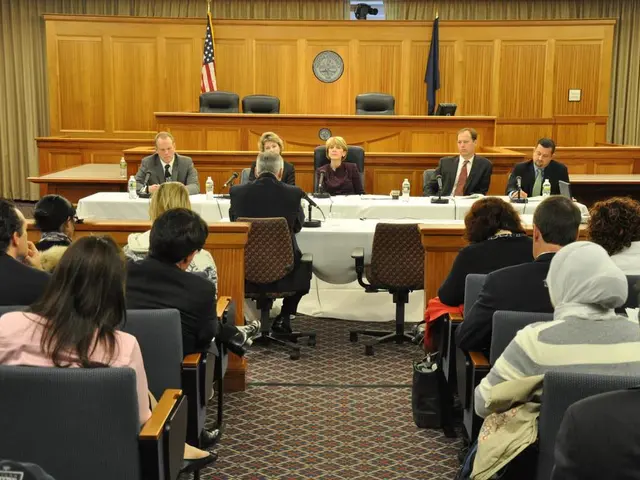Trump Warns Apple CEO Tim Cook: Impose a 25% tariff on iPhones if production isn't shifted to the U.S.
In a series of events, President Donald Trump has threatened Apple with a 25% tariff on any iPhones not made in the U.S., causing concerns for the tech giant. According to Tim Cook, existing tariffs could cost Apple $900 million this quarter.
The proposed shift in iPhone production from Asia, particularly China and India, to the U.S., presents several challenges and implications. One of the primary concerns is the **skilled labour shortage and expertise gap**. Apple's current production heavily relies on the highly skilled Chinese workforce, particularly engineers and technicians who support production and train local staff. The U.S. workforce currently lacks the specialized skills and experience in mass iPhone assembly developed in Asia over many years.
Another challenge is the **increased labor and production costs**. U.S. labor costs are significantly higher than those in China or India, which could raise production expenses substantially. Higher costs may have to be absorbed by Apple or passed on to consumers through higher iPhone prices.
Moving Apple's manufacturing to the U.S. would also involve **supply chain complexity and scale**. Apple's supply chain is deeply integrated in Asia, with suppliers, components, and logistics strongly localized there. Reconfiguring these supply networks to accommodate U.S.-based production is time-consuming and costly.
The shift could also pose **geopolitical and strategic considerations**. While it could reduce Apple’s geopolitical risk exposure linked to US-China tensions and provide supply chain resilience, China has exercised quiet measures to restrict transfer of skilled labour, technology, and equipment to rival locations like India, suggesting potential similar challenges if the move to the U.S. is pursued heavily.
Other challenges include **production efficiency and time-to-market risks**, as well as **impact on local jobs and investment** in existing Asian manufacturing hubs, particularly India, where Apple is trying to develop an alternative.
Despite these challenges, the current Treasury Secretary, Scott Bessent, believes that bringing back precision manufacturing to the U.S., particularly for semiconductors, is important. Analysts at investment bank UBS have warned that reciprocal tariffs on imported goods could drastically increase iPhone prices, adding another layer of complexity to Apple's decision-making process.
In conclusion, while shifting iPhone production to the U.S. may enhance supply chain resilience and align with political goals, Apple faces significant hurdles in replicating the technical expertise, maintaining efficiency, managing higher costs, and restructuring complex supply chains developed over years in Asia. The shift would require strategic planning, investment in workforce training, and likely a phased approach to mitigate risks.
- Gizmodo reports on the potential impact of a 25% tariff on iPhones not made in the U.S., highlighting the concerns for tech giant Apple.
- The proposed shift in iPhone production from Asia to the U.S. presents a skilled labor shortage and expertise gap.
- Apple relies heavily on the highly skilled Chinese workforce, particularly engineers and technicians.
- The U.S. workforce lacks the specialized skills and experience in mass iPhone assembly developed in Asia over many years.
- Another challenge is the increased labor and production costs in the U.S.
- Higher costs may have to be absorbed by Apple or passed on to consumers through higher iPhone prices.
- Moving Apple's manufacturing to the U.S. would involve supply chain complexity and scale.
- Apple's supply chain is deeply integrated in Asia, with suppliers, components, and logistics strongly localized there.
- Reconfiguring these supply networks to accommodate U.S.-based production is time-consuming and costly.
- The shift could pose geopolitical and strategic considerations.
- China has exercised quiet measures to restrict the transfer of skilled labor, technology, and equipment to rival locations.
- Production efficiency and time-to-market risks are other challenges.
- The impact on local jobs and investment in existing Asian manufacturing hubs, particularly India, is also a concern.
- Scott Bessent believes that bringing back precision manufacturing to the U.S., particularly for semiconductors, is important.
- Analysts at investment bank UBS have warned that reciprocal tariffs on imported goods could drastically increase iPhone prices.
- The decision-making process for Apple is made more complex by the potential iPhone price hike.
- In conclusion, Apple faces significant hurdles in replicating the technical expertise, maintaining efficiency, managing higher costs, and restructuring complex supply chains developed over years in Asia.
- Strategic planning, investment in workforce training, and a phased approach will be required to mitigate risks.
- Gizmodo also covers the future of tech and technology, keeping readers informed about the latest trends and developments.
- The future of finance is another topic of interest, with the increasing role of entrepreneurship in the industry.
- Interior design and cooking are crucial aspects of lifestyle, and Gizmodo offers tips and tricks for improving these areas.
- Leadership skills are essential for both small businesses and large corporations, and Gizmodo provides insights into effective leadership strategies.
- Diversity and inclusion are key factors in fostering a welcoming and productive work environment.
- Cybersecurity is a critical issue in today's digital age, and Gizmodo offers tips for protecting personal and business data.
- Outdoor living is a growing trend, with more people seeking ways to connect with nature.
- Fashion and beauty are important aspects of personal expression and self-care, and Gizmodo covers the latest trends in these areas.
- Food and drink play a significant role in culture and social interactions, with many regional cuisines offering unique flavors and experiences.
- Dining out is a favorite pastime for many, and Gizmodo offers restaurant reviews and recommendations for food-and-drink enthusiasts.
- Family dynamics can be complex, and Gizmodo provides resources for navigating these challenges.
- Investing in business, real estate, or a myriad of other areas requires careful planning and understanding of the market. Gizmodo offers insights into wealth management, personal finance, and investment strategies.




